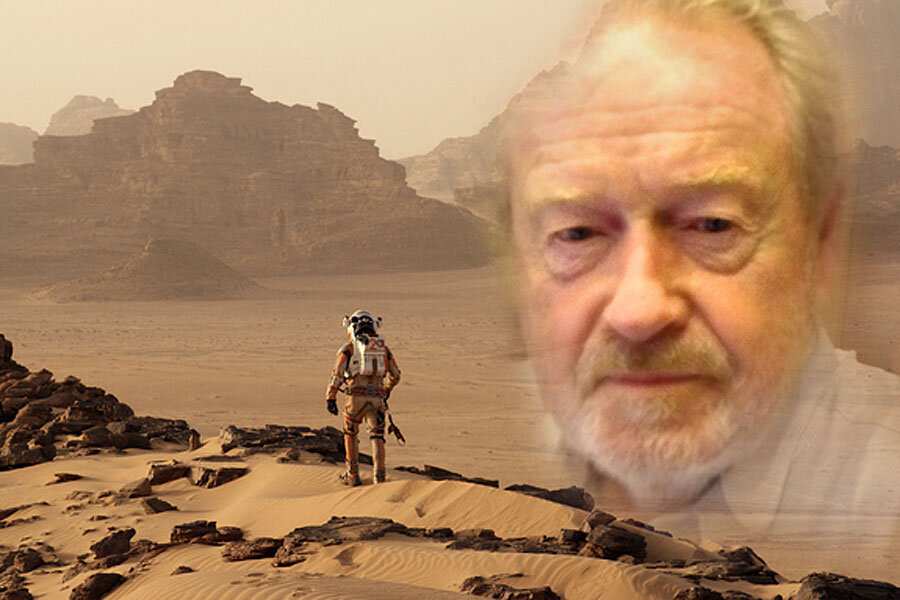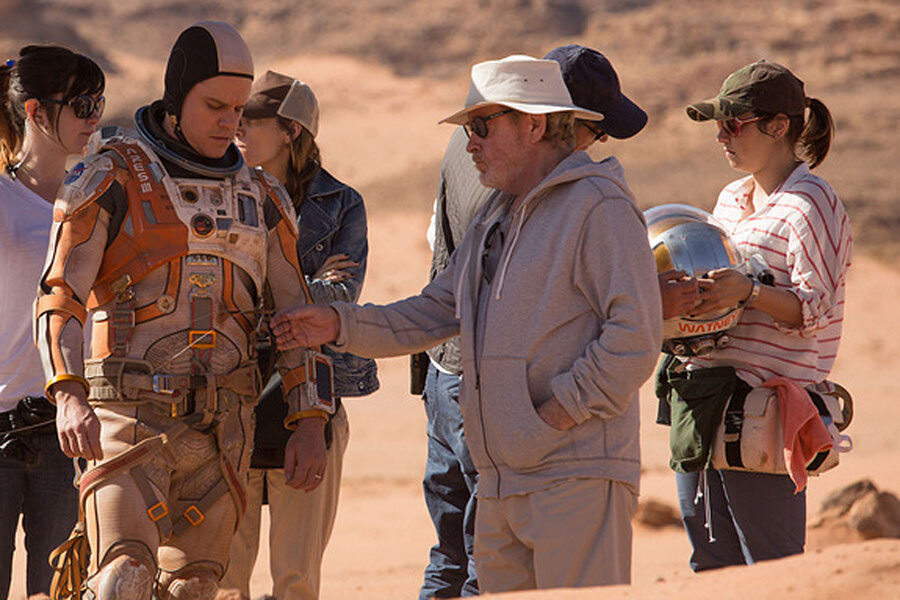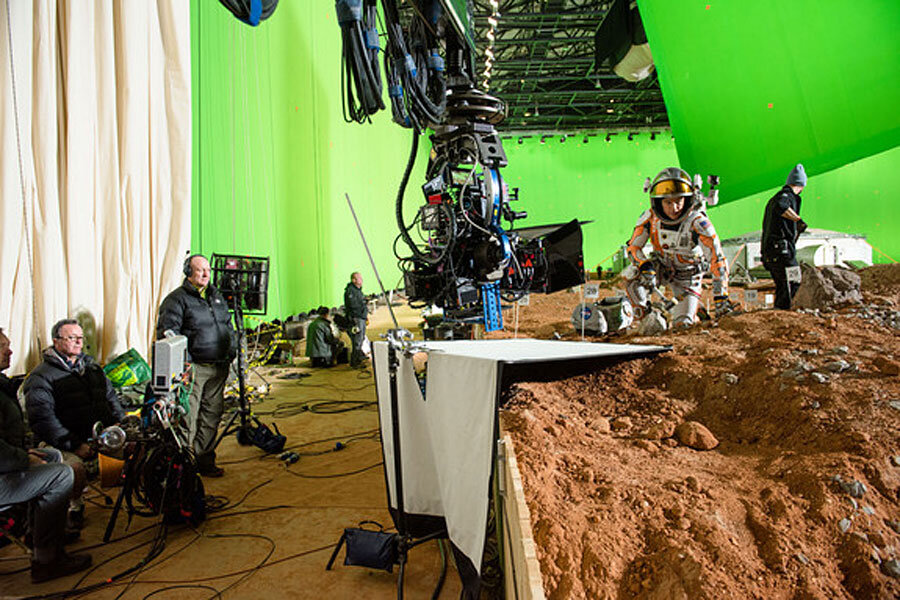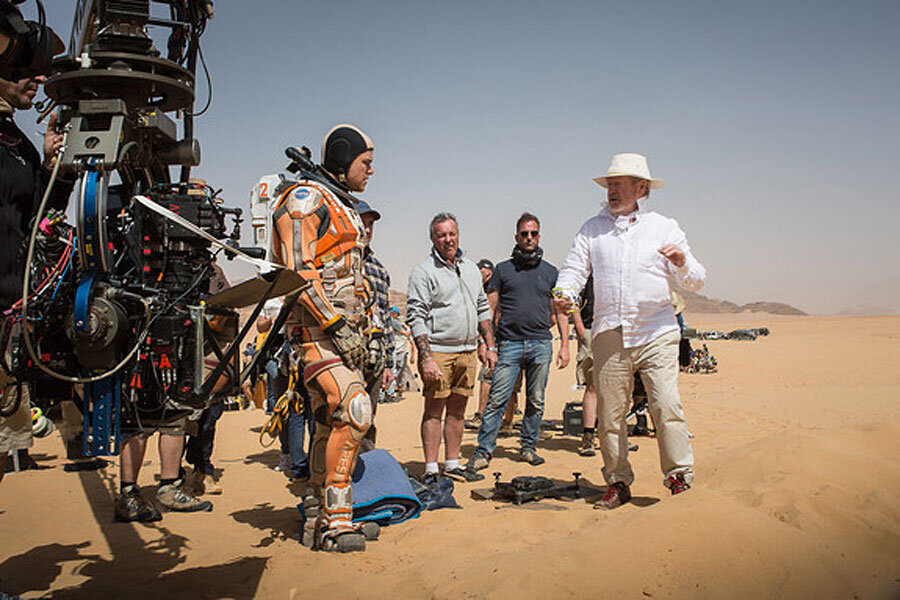An interview with 'The Martian' director Ridley Scott
Loading...
Editor's note: This story contains spoilers on the new space epic "The Martian." [So consider yourself warned. If anyone is going to spoil "The Martian" for you, it might as well be the film's director, right?]
In "The Martian," stranded astronaut Mark Watney must use his knowledge of science to survive for several years alone on the Red Planet, in a classic castaway scenario created by book author Andy Weir. The film of the same name is directed by Sir Ridley Scott, who began his screen career production-designing the BBC television series "Doctor Who" (1963) and directing the episodic police drama "Z Cars" (1965). Scott gained worldwide attention upon directing the movie "Alien" (1979), and solidified his sci-fi reputation with "Blade Runner" (1982). Scott has since directed 26 feature films and produced more than 100 movies, television series, documentaries and commercials, including the iconic "Apple Mac 1984" TV spot.
Space.com's Dave Brody spoke with Scott about the many filmmaking challenges of "The Martian," which premiered Sept. 14 at the Toronto International Film Festival. ["The Martian" and NASA: See Our Full Coverage]
Space.com: At the premiere of "The Martian," you told us that the script — as written on the page — completely intimidated you. But, if I may, Sir, you're Ridley Scott! How can any film script scare you?
Sir Ridley Scott: Well, it's actually the science. I wasn't very good at it in school. I was disastrous at mathematics, algebra, trigonometry and geometry — anything academic, in fact. I wasn't stupid. I just couldn't retain anything. I just had a block. At Grangefield Secondary School, class of 1952, I was in position 31 out of a class of 31.
I think it had something to do with the fact that I was a "war baby" and my dad became Army. So I was charging around schools. I did no less than 10 schools; most people do two. So I was totally "gaga." I was out to lunch by the time I'd done my 10th school. I "clock-watched" for five years. I kept getting my head slapped. In those days, parents didn't pay attention like they do today. [Surviving "The Martian": How to Not Die on Mars (Infographic)]
But what helps me is — I'm a bit like a caveman, you know — I draw everything.
Space.com: You predominantly think visually?
Scott: Yeah. I can really draw. I had seven years of art school. So I can literally do a very, very good storyboard. I will sit down and draw the thing out and make decisions. It's not stick men; it's really drawing — wide shots, medium shots, close shots, detail, and on and on.
It makes me understand something, or makes me prepare the scene. I'm pre-filming it on boards. My boards are thick stacks on every film, especially on a film like this, where so much is done long after principal photography.
Space.com: So you were doing pre-visualization before animatics and other previsual techniques existed?
Scott: Oh yeah — for a long time, and every time! I do pre-visualizations all the time! I do it before I start principal photography. It's great because every morning, going in, there's a reappraisal of what I've done for that day for those scenes. And then they're printed and redistributed to the first A.D. [first assistant director], lighting, cameraman, production designer — and they know what we're in for that day.
Space.com: Do you think of yourself as an orchestrator?
Scott: Yeah, yeah! Totally. You're completely accurate.
Space.com: How do you go about convincing a studio executive that you can put butts in theater seats by making a smart movie?
Scott: Well, I've always gotten away with smart movies, really. Some of them have played well. Some haven't. And at the end of the day, I've got to get off the thing of saying I'm going to go for something I really love. Smart or not so smart, the thing has to entertain. I've gotten my head slapped a few times when they didn't.
Space.com: Would you have made "The Martian" if Alfonso Cuarón hadn't been successful with "Gravity"?
Scott: Oh yeah, sure! Yes, definitely. I thought "Gravity" was a great film. It was visually very engaging. Particularly with Sandra [Bullock], who was able to hold the screen by herself for all that kind of time. It was also a marvelous orchestration of visual effects.
But I think what we've got [with "The Martian"] may be an even bigger palette, bigger vista. You've got all four quadrants, really, don't you? We've got great drama. You've got a lot of humor — which comes out of the drama, out of the reality of the situation. We've got truthful machines and technologies. And I think we've got pretty good visuals.
Space.com: Which of the machines and technologies in "The Martian" gave you the most concern?
Scott: Well, it was really only the computer code bit, because it's like math. That has always been a block to me. And, therefore, when I had to shoot the sequence about ASCII [American Standard Code for Information Interchange, a coding scheme], I went: "Whaaat?! How am I going to show this?"
I was much more into the physical aspects of what the character Rich Purnell, "steel-eyed missile man," [played by Donald Glover in the film] was doing, which was saying, "Don't slow down" as you approach Earth. Instead, use it [orbital velocity] as a slingshot; use the gravity and shoot back out [to Mars] after you've picked up the supplies. I got all that. [Watch this Rich Purnell scene from "The Martian"]
But ASCII code, fundamentally, I couldn't get my head around easily. So we just blocked it out the way the book had it.
Space.com: Andy Weir's book is such an engineering manual of how you survive on Mars that I imagine suspending the audience's disbelief was not your problem, was it?
Scott: Right!
Space.com: But did you have the opposite challenge? Did you have to work against the "geek factor" to make this entertaining?
Scott: No! I LOVED the "geek factor." Andy is a very amusing man. His entire book is rooted in a tongue-in-cheek reality. The whole bloody thing is funny! The engine of it is humor. That's what I saw. And Drew Goddard, the screenwriter, kept that integral to the story.
Space.com: Plus, you have Matt Damon, who, while not known for being a comedic actor, has incredible comedic timing and wit.
Scott: Yeah, he's great! The funniest stuff came from keeping him in the moment. He knows how to play against the drama. And, you know, the best humor comes from straight. And the "straight" is reacting against the present conditions of the person, the difficulties they're actually dealing with. Finding out about all the obstacles — that's where the humor lies. [Video: Matt Damon on "The Martian" and Education]
Space.com: You have Matt Damon's character talking to the camera a lot and also a bit of "Blade Runner"-style voiceovers.
Scott: Oh, the GoPro. You've got to have the GoPro. To me, it's the "black box." It's his companion, his man Friday [the human companion of protagonist Robinson Crusoe in Daniel Dafoe's classic novel, published in 1719]. In a real human Mars mission, you'd have a GoPro everywhere. If he died on the spot, you'd want to know why, how and what blew.
And the other thing is, we have him talking straight to the camera when he's doing his log.
Space.com: Mr. Damon told me that a lot of acting is actually reacting to the other actor. Did you go in with a game plan for directing him through these long stretches when there's no other person in the scene?
Scott: No, just basic blocking [the filmmaking technique of pre-arranging the locations of certain action and dialogue, usually by director and actor stepping through a scene]. You've got to rely on your intuition and his. Just make a choice as you see it. As a director, any decision is better than no decision. Later on, alone in your trailer, you tremble in terror that you've got it wrong. But Matt completely understood the character and nailed him perfectly. [Watch Space.com's exclusive interview with Matt Damon about "The Martian."]
Space.com: Years ago, I spoke with director Ron Howard just before his "Apollo 13" premiered, and he said it was a challenge to make a movie with no sex, no violence and no villains. You don't really have a human baddie in "The Martian" either, do you? Is the villain of this movie Mars itself?
Scott: Yes! Mars is the monster that can kill you in a heartbeat! It just doesn't care. It's a majestic monster, though. I wanted to make Mars out to be very, very beautiful, if only because we really don't know yet what it's like for people.
Space.com: Author Andy Weir says he left a lot of landscape description out of the book because it's boring for the reader. So he was especially excited to learn that you were directing; he loves your penchant for panorama and establishing a strong sense of place.
Scott: We shot exteriors at Wadi Rum [in Jordan]. To me, it's the Eighth Wonder of the World. It's incredible. It's only about 100 square miles [259 square kilometers]. And I didn't do anything but shoot it at the right time, from the right positions, then added a bit of red dust to everything. So our film world looks pretty accurate — at least I'm hoping Mars looks a little like that.
But there must be massive rocks there. You've got one dormant Mars volcano [Olympus Mons] that is 59,000 feet [18,000 meters] tall. That's 20,000 feet [6,000 m] higher than Everest! So I thought we'd be OK going to Wadi Rum to film.You know, what we see of Mars from [NASA rovers'] pictures sent back looks pretty boring: flat ground, reddish tundra, dust … That's because you're not going to land a piece of equipment in a rough mountain region. You couldn't bloody move! And you might have it go into a crevasse and — bang — a couple billion dollars is out the window. So you've got to start, at least, on pretty boring ground, right?
I cheated a bit on the skies. On Mars, they are not H2O skies; they are not condensation skies. They are dry particles. What you've got a lot of on Mars is dust! You haven't got a lot of high winds, because there's very little atmosphere — so we cheated on a lot of that. But we needed to drive the story. [Watch this scene from "The Martian"]
On Mars, there's dust on the move constantly, spiraling dust all the time. Twisters, I think they're called?
Space.com: Dust devils. They actually help sweep the dust off the solar panels on NASA's real Mars rovers.
Scott: Right! They're not truly dangerous. The atmosphere is too thin to carry much force. But besides not being able to breathe, the truly treacherous thing on Mars — I've learned from the guys at NASA — is temperature: When you hit dark, you're at minus 90 degrees Fahrenheit [minus 68 degrees Celsius] at the surface. You go up top, you're at minus 150 F [minus 101 C]. Either way, you're dead. That, too, is because of the thin atmosphere. [The AstroCritic: What "The Martian" Gets Right About Astronauts]
Space.com: And the plot depends on that thin atmosphere, especially in getting Watney off of Mars, yes?
Scott: Yeah, where there's an argument within NASA near the film's end, where Watney will be asked to take the nose off the MAV [Mars Ascent Vehicle] to lighten it — because it weighs 400 lbs. [181 kilograms] or something, and they need to make every ounce of fuel count. So what are they going to do? He'll put a canvas over it. So they're going to fly him up to orbit in a convertible!
Space.com: It's a very cute scene. But could the pilot onboard the orbiting mother ship actually control Watney's MAV from the ground up?
Scott: NASA [the real NASA] said, "Yes, if they leave the right components in the ship." So Watney dismantles a lot of the ship, but leaves the communications in there so they can fly him up.
We tried to be authentic wherever we could. I kept in the docking just the way it's really done. We modeled the ports on the way ESA [the European Space Agency] delivers to the International Space Station.
Scott: No, I don't think it's entirely down to the risk. It's also the cost. There are plenty of people who are lunatic enough to go up there. Why? I wouldn't go up there, particularly as we can probably reconstruct it.
Space.com: Mars is a risky place to be. Do you think humanity has become too risk-averse to actually send people there?
Scott: Many say space travel will be "the thing." But incredibly detailed digital reconstruction is probably what's going to happen. We got probes with sensors.
We got one vehicle that's been on the move since 1977 [Voyager 1], and others that send back incredible pictures [Curiosity]. They're not film photographs. They're radio data, which NASA then takes, reconstructs and conforms into a digital picture. And the images are fantastic, but they're not artistic — it's real.
Space.com: But do you think we're going to send people back to the moon, to the asteroids, to Mars, maybe to the moons of Jupiter?
Scott: It's a hard thing. They've got to do so much on their own. The moon is close, like three days' travel; beyond that is tough. Mars — if you go by radio signals at the speed of light — at its closest position to Earth takes about four and half minutes. At the longest position — because Earth overtakes Mars orbiting around the sun — it takes about 22 minutes [for radio communications, travelling at the speed of light]. The distance ranges from about 40 million miles[64 million km] to over 140 million miles [225 million km]. And that's just a heartbeat — just a blink — in comparison to everywhere else!
That means you've got to look very closely at whether we're going to be able to "hypersleep," or essentially hibernate. And most of all, how the hell are we going to be able to approach light speed?!
Space.com: Speaking of light speed and beyond, earlier, you referenced that scene near the end of "The Martian," where Watney is violently blasting off in the MAV. And you have his head shuttering and bouncing around inside his helmet. Was that a knowing homage to [filmmaker Stanley] Kubrick and [character] Dave Bowman [of "2001 - A Space Odyssey"] going through that psychedelic space-time transition? Or was that just vintage Ridley Scott fast-shutter-speed, strobe-y "staccato" camera technique?
Scott: (Laughs) I wish I'd thought about it that much! Actually, what happened is that the lights went wrong! But I liked it. In the physical vibration [put onto Damon], they started to lose the light. And I thought, "Wow, that looks terrific!" So I used the take where the shot went simply wrong.
And the final touch was, I used all the nuts and bolts that must have come loose or been left during demolition. So now, they're in their own orbit, floating around his helmet.
Space.com: So it's a way of saying, "He's back in space. He made it clear of "Mars, the monster"?
Scott: "Precisely!"
Check out Space.com's full coverage of "The Martian" Ridley Scott's sci-fi film, based on the novel by Andy Weir, which opens October 2.
Follow us @Spacedotcom, Facebook or Google+. Originally published on Space.com.
- How To Kill (Or Save) A Martian – Author Andy Weir Knows! | Video
- Exclusive Video Interview with Matt Damon
- 'The Martian' Director Ridley Scott Promotes NASA’s Mars Dreams | Video
Copyright 2015 SPACE.com, a Purch company. All rights reserved. This material may not be published, broadcast, rewritten or redistributed.










